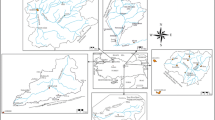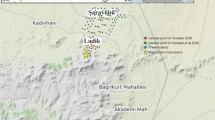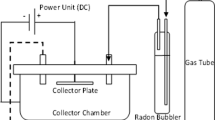Abstract
In this study, radiological distribution of gross alpha, gross beta, 226Ra, 232Th, 40K, and 137Cs for a total of 40 natural spring water samples obtained from seven cities of the Eastern Black Sea Region was determined by artificial neural network (ANN) method. In the ANN method employed, the backpropagation algorithm, which estimates the backpropagation of the errors and results, was used. In the structure of ANN, five input parameters (latitude, longitude, altitude, major soil groups, and rainfall) were used for natural radionuclides and four input parameters (latitude, longitude, altitude, and rainfall) were used for artificial radionuclides, respectively. In addition, 75 % of the total data were used as the data of training and 25 % of them were used as test data in order to reveal the structure of each radionuclide. It has been seen that the results obtained explain the radiographic structure of the region very well. Spatial interpolation maps covering the whole region were created for each radionuclide including spots not measured by using these results. It has been determined that artificial neural network method can be used for mapping the spatial distribution of radioactivity with this study, which is conducted for the first time for the Black Sea Region.















Similar content being viewed by others
References
Amanatiadis, A., Mitsinis, N., Maditinos, D., 2014. A neural network-based approach for user experience assessment. Behaviour a & Information Technology. 1–12. doi:10.1080/0144929X.2014.921728.
Bagheri, M., Mirbagheri, S. A., Ehteshami, M., & Bagheri, Z. (2014). Modeling of a sequencing batch reactor treating municipal wastewater using multi-layer perceptron and radial basis function artificial neural networks. Process Safety and Environmental Protection, 93, 1–13. doi:10.1016/j.psep.2014.04.006.
Bonotto, D. M., Bueno, T. O., Tessari, B. W., & Silva, A. (2009). The natural radioactivity in water by gross alpha and beta measurements. Radiation Measurements, 44, 92–101. doi:10.1016/j.radmeas.2008.10.015.
Damla, N., Cevik, U., Karahan, G., Kobya, A. I., Kocak, M., & Isık, U. (2009). Determination of gross α and β activities in waters from Batman, Turkey. Desalination, 244, 208–214. doi:10.1016/j.desal.2008.05.024.
Das, S., Bhattacharya, A., Haldar, S., Ganguly, A., Gu, S., Ting, Y. P., & Chatterjee, P. K. (2015). Optimization of enzymatic saccharification of water hyacinth biomass for bio-ethanol: comparison between artificial neural network and response surface methodology. Sustainable Materials and Technologies. doi:10.1016/j.susmat.2015.01.001.
Degerlier, M., & Karahan, G. (2010). Natural radioactivity in various surface waters in Adana, Turkey. Desalination, 261, 126–130. doi:10.1016/j.desal.2010.05.020.
Desideri, D., Roselli, C., Feduzi, L., & Meli, M. A. (2007). Radiological characterization of drinking waters in Central Italy. Microchemical Journal, 87, 13–19. doi:10.1016/j.microc.2007.04.006.
EUR 21595 EN (2005). Automatic mapping algorithms for routine andemergency monitoring data. Report on the spatial interpolation comparison 2004 (SIC2004) exercise. In:Dubois, G.(Ed). Luxembourg.
Falamaki, A. (2013). Artificial neural network application for predicting soil distribution coefficient of nickel. Journal of Environmental Radioactivity, 115, 6–12. doi:10.1016/j.jenvrad.2012.06.008.
Farah, J., Henriet, J., Broggio, D., Laurent, R., Fontaine, E., Chebel-Morello, B., Sauget, M., Salomon, M., Makovicka, L., & Franck, D. (2011). Development of a new CBR-based platform for human contamination emergency situations. Radiation Protection Dosimetry, 144, 564–570. doi:10.1093/rpd/ncq440.
Fatima, I., Zaidi, J. H., Arif, M., & Tahir, S. N. A. (2007). Measurement of natural radioactivity in bottled drinking water in Pakistan and consequent dose estimates. Radiation Protection Dosimetry, 123, 234–240. doi:10.1093/rpd/ncl093.
Forte, M., Rusconi, R., Cazzaniga, M. T., & Sgorbati, G. (2007). The measurement of radioactivity in Italian drinking waters. Microchemical Journal, 85, 98–102. doi:10.1016/j.microc.2006.03.004.
Görür, F. K., Keser, R., Dizman, S., & Okumuşoğlu, N. T. (2011). Annual effective dose and concentration levels of gross α and β in various waters from Samsun, Turkey. Desalination, 279, 135–139. doi:10.1016/j.desal.2011.05.071.
Günther, F., & Fritsch, S. (2010). Neuralnet: training of neural networks. The R Journal, 2, 30–38.
Hagan, M. T., & Menhaj, M. B. (1994). Training feedforward networks with the Marquardt algorithm. IEEE Transactions on Neural Networks, 5, 989–993. doi:10.1109/72.329697.
Karabulut, A. (2012). CBS ve UA Bilgi Yönetimi Bölümü Çalışmaları ve Projeksiyonlar (in Turkish http://www.webcitation.org/6WXhCere0), in: 17. ESRI Users Group Meeting Turkey. Ankara.
Kiliç, Ö., Belivermiş, M., Topcuoğlu, S., & Çotuk, Y. (2009). Th-232, U-238, K-40, Cs-137 radioactivity concentrations and Cs-137 dose rate in Turkish market tea. Radiation Effects and Defects in Solids, 164, 138–143. doi:10.1080/10420150802681530.
Kobya, Y., & Yeşilkanat, C. M. (2014). Investigation of Cs-137 and K-40 activities of natural spring waters of the Eastern Black Sea Region, Turkey. Environmental Earth Sciences. doi:10.1007/s12665-014-3792-6.
Kobya, Y., Damla, N., Cevik, U., Kobya, A. I., Taskın, H., & Kemer, B. (2010). Radiological characterization of natural spring waters in the Eastern Black Sea Region, Turkey. Environmental Forensics, 11, 187–192.
Kobya, Y., Taşkın, H., Yeşilkanat, C. M., Varinlioğlu, A., & Korcak, S. (2014). Natural and artificial radioactivity assessment of dam lakes sediments in Çoruh River, Turkey. Journal of Radioanalytical and Nuclear Chemistry. doi:10.1007/s10967-014-3420-7.
Negarestani, A., Setayeshi, S., Ghannadi-Maragheh, M., & Akashe, B. (2002). Layered neural networks based analysis of radon concentration and environmental parameters in earthquake prediction. Journal of Environmental Radioactivity, 62, 225–233. doi:10.1016/S0265-931X(01)00165-5.
Otağ, İ., Otağ, A., Akkoyun, S., Çimen, M., 2015. Estimation of the femur length from its proximal measurements in Anatolian Caucasians by artificial neural networks. Australian Journal of Forensic Sciences. 1–8. doi:10.1080/00450618.2015.1004193.
Pebesma, E. J., & Bivand, R. S. (2005). Classes and methods for spatial data in R. R News, 4, 9–13.
Quantum GIS Development Team (2014). Quantum GIS Geographic Information System. Open Source Geospatial Foundation Project.
R Development Core Team (2005). R: A language and environment for statistical computing, reference index version 2.2.1 [WWW Document]. R Foundation Statistical Computing. URL http://www.r-project.org/.
Raza, M., Hussain, F. K., & Hussain, O. K. (2012). Neural network-based approach for predicting trust values based on non-uniform input in mobile applications. Computer Journal, 55, 347–378. doi:10.1093/comjnl/bxr104.
Rumelhart, D. E., Hinton, G. E., & Williams, R. J. (1986). Learning internal representations by error propagation. Parallel Distributed Processing: Explorations in the Microstructure of Cognition, 1, 318–362. Cambridge, MA: MIT Press Cambridge.
Şen, Z. (2004). Yapay sinir ağları ilkeleri. İstanbul: Su vakfı Publisher (in Turkish. ISBN 975-6455-13-6).
Taskin, H., Asliyuksek, H., Bozkurt, A., & Kam, E. (2013). Natural radioactivity in bottled mineral and thermal spring W. Radiation Protection Dosimetry, 157, 575–578.
Vega-Carrillo, H. R., Hernamdez-Davila, V. M., Manzanares-Acuna, E., Gallego, E., & Lorente, A. (2007). Artificial neural networks technology for neutron spectrometry and dosimetry. Radiation Protection Dosimetry, 127, 408–412. doi:10.1093/rpd/ncm084.
Zjavka, L. (2014). Short-term power demand forecasting using the differential polynomial neural network. International Journal of Computational Intelligence Systems, 8, 297–306. doi:10.1080/18756891.2015.1001952.
Author information
Authors and Affiliations
Corresponding author
Rights and permissions
About this article
Cite this article
Yeşilkanat, C.M., Kobya, Y. Determination and mapping the spatial distribution of radioactivity of natural spring water in the Eastern Black Sea Region by using artificial neural network method. Environ Monit Assess 187, 589 (2015). https://doi.org/10.1007/s10661-015-4811-0
Received:
Accepted:
Published:
DOI: https://doi.org/10.1007/s10661-015-4811-0




